
Following Russian circumnavigation route
/ Главная / Russkiy Mir Foundation / Publications / Following Russian circumnavigation routeFollowing Russian circumnavigation route
Since their catamaran was wrecked by shark attacks near Australia, Russian travelers have been raising funds for a new vessel to continue round-the-world expedition organized by the Tomsk branch of the Russian Geographical Society (RGS).
Evgeny Kovalevsky, the leader of the expedition "Following the Russian Circumnavigators' Route", comes from a long line of Tomsk residents. He is a candidate of engineering sciences, professor of geography, vice-president of the Tomsk branch of the Russian Geographical Society, Outstanding Traveler of Russia title holder, international master of sports in athletic tourism, champion of Russia in sailing trips, champion of Russia in extreme rafting, and the absolute champion of Russia in extreme travel.
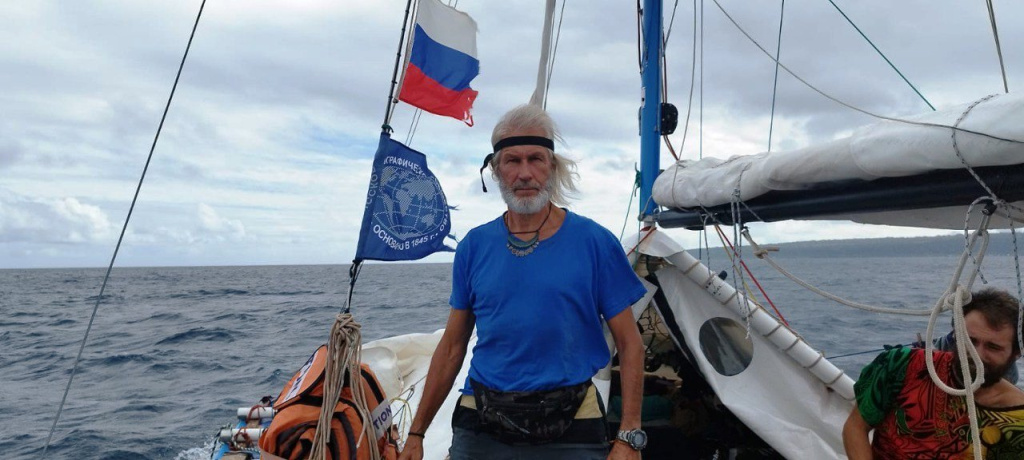
Evgeny Kovalevsky. Photo credit: russianoceanway / Telegram
– Mr. Kovalevsky, tell us please how your previous life experience is connected with extreme sea voyages.
– My whole life has been about extreme travel. I became a traveler when I was 17 years old. Now I'm 66. A year later, it will be the 50th anniversary of my extreme travels. I used to practice extreme rafting for many years. I spent 35 years rafting the most challenging rivers in the Soviet Union. In 1998, I started rafting in the Himalayas. I have completed more than 20 extreme trips in the Kingdom of Nepal, Tibet, and the Kingdom of Bhutan.
My team set a goal to raft all the most difficult rivers in Nepal, and then to raft the Everest's rivers. Our Tomsk team made the world's first extreme rafting in the upper canyons of Arun, Everest's northern River, and first completed several rafting trips in the canyons of Dhudh Kosi, Everest's southern river. It was extremely challenging and deadly. All rivers that spring from the Himalayan slopes run to the Indian Ocean. This is how my life went from the rivers and mountains to the ocean. The Indian Ocean caught my attention when one of my friends offered me to take a risk and cross the Indian Ocean on an inflatable sailing catamaran. It was said and done.
In 2006, we successfully crossed the Indian Ocean on an inflatable beach catamaran that usually floats freshwater lakes. My friend improved the design and we made it across the Atlantic Ocean on an inflatable trimaran in 2010-2011. These were our first experiences of crossing the ocean on inflatable boats. A few years later we used the inflatable catamaran to cross the Pacific Ocean.
Eventually, the Tomsk branch of the Russian Geographical Society initiated a project that entailed the first circumnavigation on an inflatable sailing catamaran. Three people became the ideologists of this project. They were Yulia Kalyuzhnaya, the executive director of the Tomsk RGS, me, Evgeny Kovalevsky, a Geography Professor at Tomsk State University, and Stanislav Beryozkin, a sailor. The project development took 8 years in total.
On July 1, 2021, a crew of two people - Evgeny and Stanislav - took a sailing catamaran and began "Following the Russian Circumnavigators' Route", an extreme round-the-world expedition of the Russian Geographical Society. As of today, we have been participating in our project for ten years, including two years of sailing.
Our fundamental idea is to remind the world of Russia's maritime glory and follow the path of the first Russian circumnavigators of the nineteenth century. Let us recall that there were 100 round-the-world expeditions by sailors from different countries in the nineteenth century. Half of them were accomplished by Russian sailors.
Let us also remember that Adam Johann von Krusenstern became the first Russian circumnavigator in 1803 and that Fabian Gottlieb von Bellingshausen discovered Antarctica and several hundred islands in the Pacific Ocean. The results of their explorations are still used by the entire civilized world.
– Could you please tell us more about the implementation of your project?
– It is important to emphasize that our project is a nineteenth-century one. Let us recall that back then, it had to include the implementation of several practical programs in addition to the extreme ocean voyage.
One of our priorities is the educational program. We prepare and conduct online lessons of true geography every 3 to 4 months. Yulia became the main ideologist and coordinator of the Lessons from the Ocean program. The lessons are linked to the locations where our crew is sailing on the catamaran. For example, if the destination is Easter Island, the theme of the lesson would be Easter Island. Thousands of children can see and ask us questions through Zoom. We want to develop an educational cluster with ten lessons of fifty minutes each and propose this cluster to the Russian Ministry of Education. We have already produced and conducted 6 lessons and continue to create new ones along the expedition route.
We also have an environmental program observing the litter spreading in the ocean, analyzing the reasons behind the trash islands formation, etc.
The psychological state of the crew and the behavior of people in long-term cohabitation in a confined space are also topics in our scientific interest. The solution to the above issues is important for long space flights, as well as months-long extreme scientific and sporting expeditions, scientific and economic teams' activities in the Arctic and Antarctic, etc. Our scientific research is based on the assignments from the Tomsk Branch of the Russian Geographical Society and Tomsk universities.
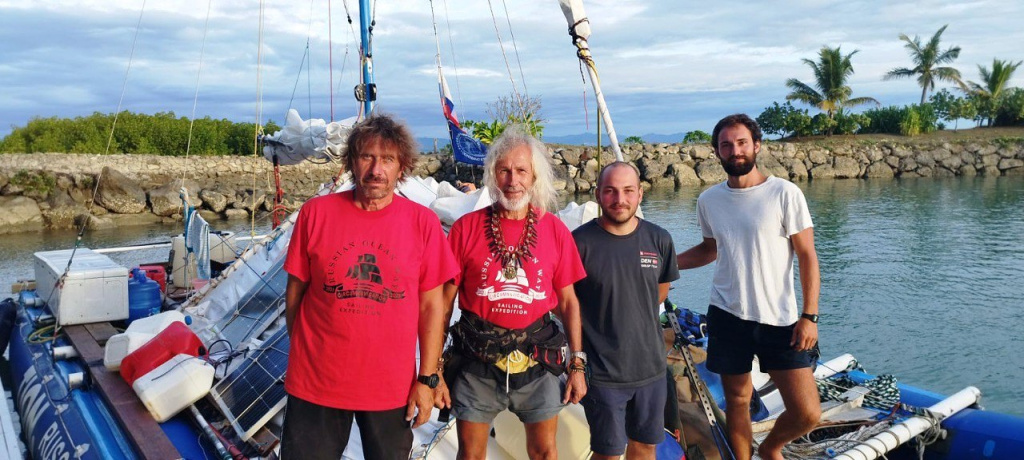
Expedition members visiting Fiji. Photo credit: russianoceanway / Telegram
– Could you please describe your vessel?
– Our catamaran includes inflatable cylinders with a metal tube frame fixed on them. There is a mast and a tent for four people in the center of the catamaran. This floating structure can travel the sea at a positive speed. It is designed to survive the high waves, headwinds, crosswinds, and possible collisions with reefs. Up to now, nobody in the world has ever circumnavigated the globe on inflatable vessels within one expedition. So, it is an experiment!
The vessel was built to our order by a designer from St. Petersburg. The version we used to start the expedition from Kronstadt two years ago was called a trimaran because the frame was attached to three cylinders. We faced a strong storm 800 miles before Easter Island. The steel steering gear broke apart, we lost control and sent out an SOS signal. We were rescued and the ocean took the trimaran with all its equipment.
We continued the expedition using the same designer's inflatable vessel. We left Easter Island and almost reached Australia. The catamaran was destroyed during a shark attack and we survived once again. As a result, we have already lost two vessels during this circumnavigation. So, our crew is doing well but the vessels are not. After the loss of the second vessel and a miraculous rescue, we ended up in Australia.
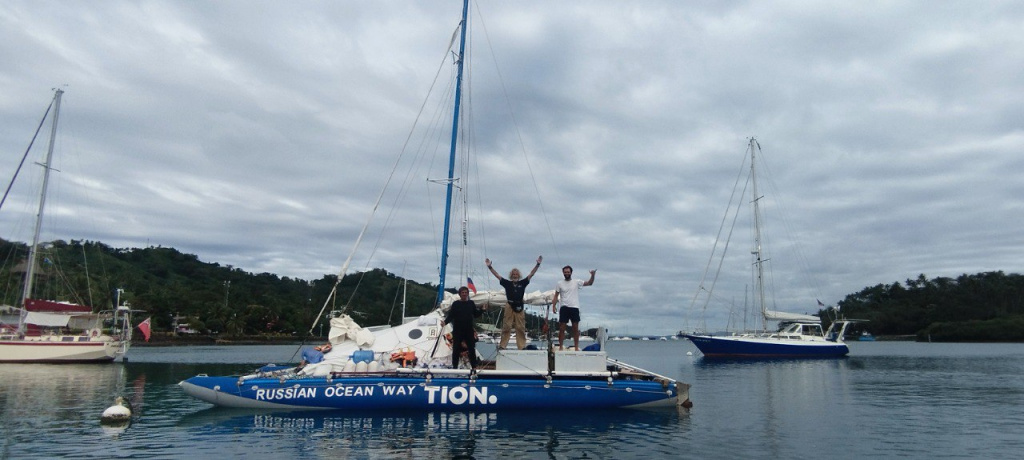
Photo credit: russianoceanway / Telegram
– How was your everyday life organized onboard?
– Our crew includes two people (Stas and me), and our tent has enough sleeping space for four people. At each port of call, we invite sailors or ordinary residents to join us. People respond to our invitation enthusiastically. About 30 people from Russia, Brazil, Argentina, Chile, France, and Argentina have traveled with us over the past two years. Vincent, a Frenchman, was with us on a trip from Tahiti to Australia. This way, we are implementing one more program "Friendship of Peoples". When we stop to restock our water and food supplies, we hold meetings and tours and share stories about our expedition. Our experience is extremely interesting to yachtsmen all over the world - no one has ever thought that it is possible to cross oceans on inflatable vessels. Yet here we are, Russian sailors, traveling around the world on an inflatable vessel - it's amazing!
We make historical films drawing parallels with nineteenth-century Russian travelers. We visit the same islands that our predecessors did. We take pictures of monuments to Russian navigators, for example, to Fabian Gottlieb von Bellingshausen in Rio de Janeiro, Vasily Golovnin in Vanuatu, and others. Our films have been watched in Russia and in the countries we have visited.
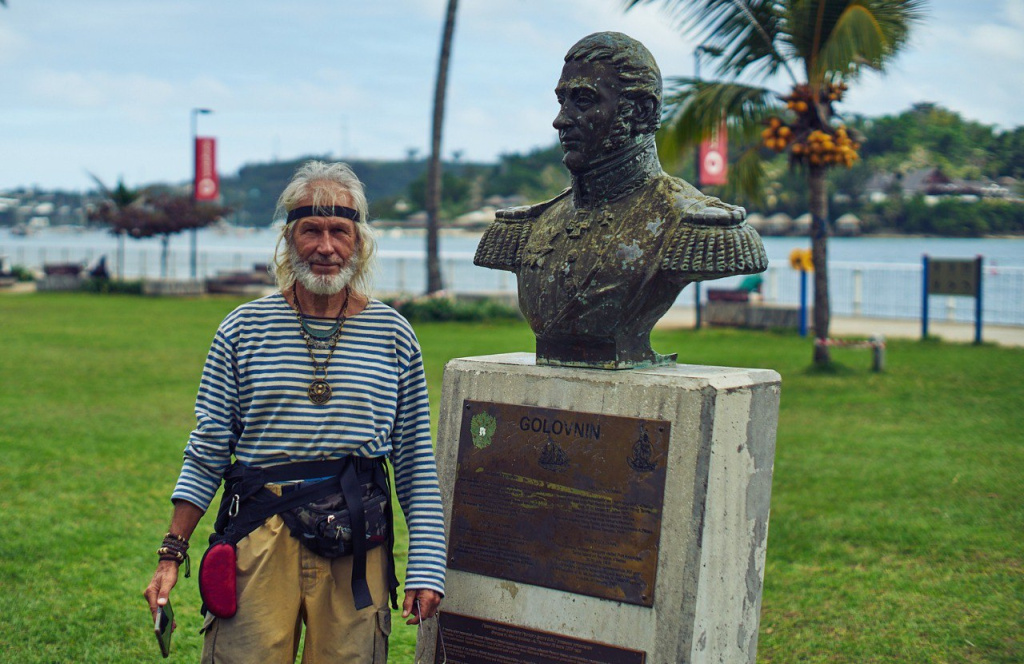
Monument to Vladimir Golovnin, Vanuatu. Photo credit: russianoceanway / Telegram
Our daily routine is simple.
We sleep in sleeping bags. Sometimes, saltwater splashes into them, and we sleep in wet, salty sleeping bags. During the months we sailed around South America, it was freezing cold. Zero degrees in the open ocean is really cold. The wind blows, there is no sun at night, and often cold waves lapping at the deck and watchmen. I put on three or four pants and two or three hats. Basically, it is a winter way of dressing. We have even come up with a new term "fierce south" to reflect the harsh southern weather.
We have a gas cylinder and a gas stove so we can cook noodles, rice, tea, and coffee. There is no refrigerator as power is insufficient. We have two solar panels to charge two car batteries. The latter are used to charge phones and cameras.
Read also: Across the oceans in Old Russian vessel rook
We don't have an autopilot, so there is one person sitting on the watch chair on the deck and operating the catamaran at any given time. If the weather is rough, we declare an emergency, and everyone combats the elements. Our clothes and sleeping bags are wet and salty. We have chronic sleep deprivation. Yet, sometimes we can read an e-book if we have time and the desire to do so.
We enjoy watching the ocean, sunsets, and sunrises. It's just wonderful. At night, dolphins come to befriend us. This is what it's like to live in the wilderness!
– How did the wreck occur?
– During our previous trip across the Atlantic Ocean, we encountered a situation when our cylinders' bottoms were punched in the center of the ocean where the depths were great. Gradually, we found out about Cookie Cutters. These are deep-sea sharks. They are small, 23.6 inches long but their teeth are as sharp as a saw.
Cookie cutters hunt whales. At night or early in the morning, they usually come to the ocean surface from a depth of two or three kilometers. They choose a victim, speed up, crash into the whale's belly, and suck in. Their lips are like suction cups. They gnaw off a piece of the whale's body and swim away. It is the ocean's most predatory fish that lives in tropical areas.
Read also: Fyodor Konyukhov: "Now all the world records are ours."
Our encounters with these sharks started on our way from Easter Island to French Polynesia. This is already tropical waters., and sharks started attacking us there. We were saved by the fact that the holes caused by shark attacks in the catamaran's cylinders could be repaired on nearby islands. We saw dozens of shark teeth marks in Fiji. Shark attacks started again in the Coral Sea on September 3 and 4, 2023. We were sailing one thousand three hundred miles from Vanuatu to Cairns. First, the sharks bit the stern of the left cylinder. The stern sagged. Each of our two cylinders has four sections. Unfortunately for us, the stern section was damaged after the first attacks. On September 5, 2023, during the day, we managed to somehow patch the hole. However, it became apparent that if the stern of the right cylinder was punctured, we would sink.
This is what happened the following night. We anticipated it and called Yulia Kalyuzhnaya in our Coastal Headquarters in advance. We informed her about the real danger we were facing. Yulia Kalyuzhnaya and Russian Australian Natalia Ahrens, Australian Rescue Services, and the Panamanian dry cargo ship "Dugong Ace", which was sent to rescue us, acted promptly. We are very grateful to them all for that.
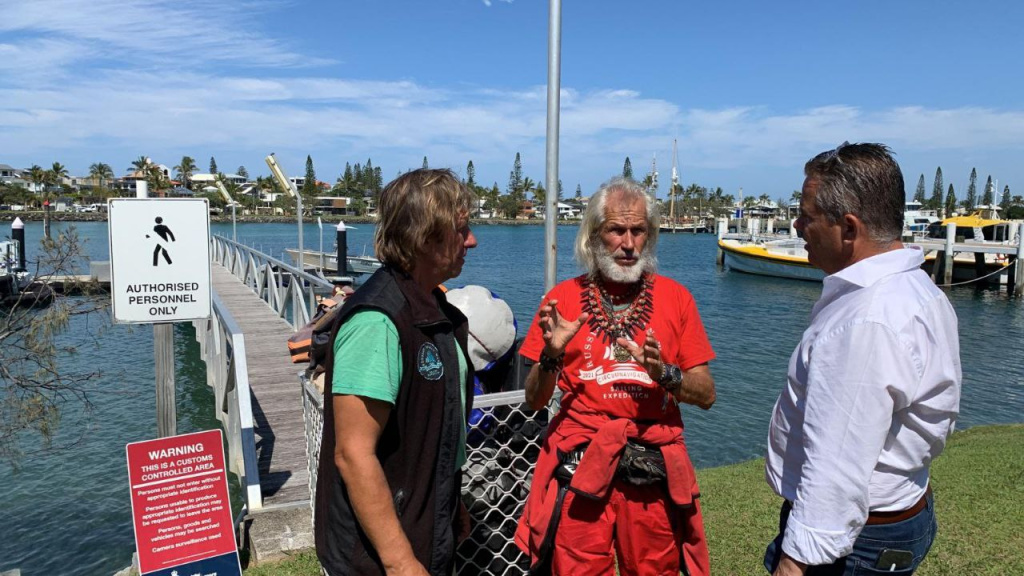
Travelers make a landing in Australia. Photo credit: russianoceanway / Telegram
Forty-five minutes after the alarm was declared, a huge Panama-flagged cargo ship heading from Australia to Shanghai approached us. We spent an hour and a half trying to get on it. Its board was 49 ft. high, and we were almost in the water. Our half-sunken inflatable catamaran was getting sucked under the bottom of the ship. Finally, we got on board by five o'clock in the morning. The crew was very kind to us, we were provided with water, food, and a cabin for each of us. Despite the stress of what had happened, half an hour after boarding the dry cargo ship, Yulia, Stanislav, and I held a short meeting over the phone and decided that the expedition should be continued.
We were taken to Brisbane. We are very grateful to the Russian Embassy in Australia. It helped us to get accommodated in Brisbane through our compatriots. We are staying with the Lashins. Vladimir and Svetlana have welcomed us like family.
– What are your first impressions of Australia
– It is clean everywhere. There are good roads and good houses. The standard of living is high, and people are happy. We climbed a high mountain and looked at Brisbane from above at night. It is beautiful! These are my very first impressions of Australia! I love it here! Everything is great!
I go jogging in the mornings. While jogging, I greet Australians walking their dogs. I always get a friendly response from the locals. Australians are friendly, smiling, and attentive.
For instance, we entered a store to buy SIM cards and immediately sensed the positive attitude of the store managers toward us. Everyone radiated positive attitudes - the salespeople and the customers.
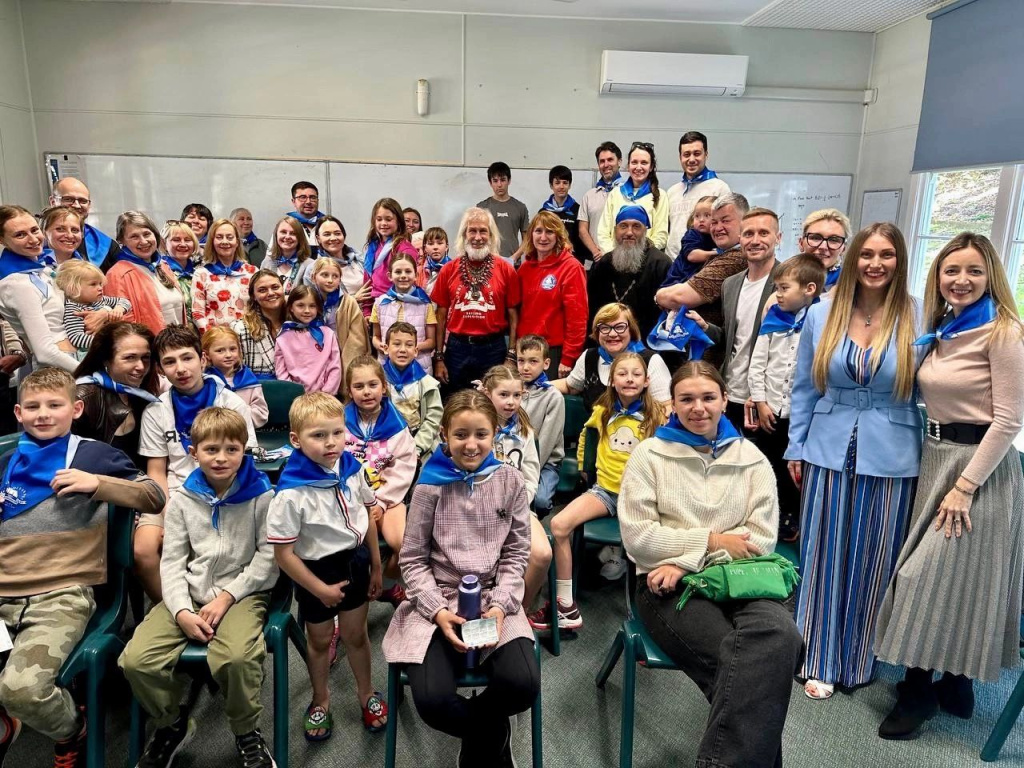
The meeting of the team and Australian residents with the support of the Embassy of the Russian Federation. Photo credit: russianoceanway / Telegram
– What's next? Share your plans for the future, please.
– The initial plan was to stay in Cairns, repair the boat, buy supplies, hold several meetings with compatriots and Australian sailors, share our experience of sailing across the ocean on an inflatable vessel, and take pictures of historical and cultural monuments.
However, we lost the vessel and equipment in the emergency. Now it is important to figure out how we are going to proceed. Continuing the expedition is vital for us. All Russian circumnavigators of the nineteenth century sailed from Kronstadt and returned to Kronstadt. We must repeat this route. It will take about eight months to get from Australia to Kronstadt through the Indian Ocean, the Red and Mediterranean Seas, the North Sea, and the Baltic Sea. We need to leave Australia within the next six weeks to return to Russia before the summer of 2024.
We are deeply grateful to the Russian Embassy in Australia, patrons, compatriots, and the entire Russian community for their support and assistance!
Source: The Horizon Newspaper (Australia), Issue No. 40 (October 5, 2023)
New publications

 Mikhail Kalatozov, a director who transformed the world of cinematography in many ways, was born 120 years ago. He was a Soviet film official and a propagandist. Above all, he was capable of producing movies that struck viewers with their power and poetic language.
Mikhail Kalatozov, a director who transformed the world of cinematography in many ways, was born 120 years ago. He was a Soviet film official and a propagandist. Above all, he was capable of producing movies that struck viewers with their power and poetic language.  Ukrainian authorities have launched a persecution campaign against the canonical Ukrainian Orthodox Church (UOC), the biggest one in the country's modern history. Over the past year, state sanctions were imposed on clergy representatives, searches were conducted in churches, clergymen were arrested, criminal cases were initiated, the activity of the UOC was banned in various regions of the country, and monasteries and churches were seized.
Ukrainian authorities have launched a persecution campaign against the canonical Ukrainian Orthodox Church (UOC), the biggest one in the country's modern history. Over the past year, state sanctions were imposed on clergy representatives, searches were conducted in churches, clergymen were arrested, criminal cases were initiated, the activity of the UOC was banned in various regions of the country, and monasteries and churches were seized.  When Nektary Kotlyaroff, a fourth-generation Russian Australian and founder of the Russian Orthodox Choir in Sydney, first visited Russia, the first person he spoke to was a cab driver at the airport. Having heard that Nektariy's ancestors left Russia more than 100 years ago, the driver was astonished, "How come you haven't forgotten the Russian language?" Nektary Kotlyaroff repeated his answer in an interview with the Russkiy Mir. His affinity to the Orthodox Church (many of his ancestors and relatives were priests) and the traditions of a large Russian family brought from Russia helped him to preserve the Russian language.
When Nektary Kotlyaroff, a fourth-generation Russian Australian and founder of the Russian Orthodox Choir in Sydney, first visited Russia, the first person he spoke to was a cab driver at the airport. Having heard that Nektariy's ancestors left Russia more than 100 years ago, the driver was astonished, "How come you haven't forgotten the Russian language?" Nektary Kotlyaroff repeated his answer in an interview with the Russkiy Mir. His affinity to the Orthodox Church (many of his ancestors and relatives were priests) and the traditions of a large Russian family brought from Russia helped him to preserve the Russian language.

 The leaders of the Friends of the Great Russia cultural association (Amici Della Grande Russia) in Italy believe that the Western policy of abolishing Russian culture in Europe has finally failed. Furthermore, it was doomed to failure from the beginning.
The leaders of the Friends of the Great Russia cultural association (Amici Della Grande Russia) in Italy believe that the Western policy of abolishing Russian culture in Europe has finally failed. Furthermore, it was doomed to failure from the beginning.  Name of Vladimir Nemirovich-Danchenko is inscribed in the history of Russian theater along with Konstantin Stanislavski, the other founding father of the Moscow Art Theater. Nevertheless, Mr. Nemirovich-Danchenko was a renowned writer, playwright, and theater teacher even before their famous meeting in the Slavic Bazaar restaurant. Furthermore, it was Mr. Nemirovich-Danchenko who came up with the idea of establishing a new "people's" theater believing that the theater could become a "department of public education."
Name of Vladimir Nemirovich-Danchenko is inscribed in the history of Russian theater along with Konstantin Stanislavski, the other founding father of the Moscow Art Theater. Nevertheless, Mr. Nemirovich-Danchenko was a renowned writer, playwright, and theater teacher even before their famous meeting in the Slavic Bazaar restaurant. Furthermore, it was Mr. Nemirovich-Danchenko who came up with the idea of establishing a new "people's" theater believing that the theater could become a "department of public education."  "Russia is a thing of which the intellect cannot conceive..." by Fyodor Tyutchev are famous among Russians at least. December marks the 220th anniversary of the poet's birth. Yet, he never considered poetry to be his life's mission and was preoccupied with matters of a global scale. Mr.Tyutchev fought his war focusing on relations between Russia and the West, the origins of mutual misunderstanding, and the origins of Russophobia. When you read his works today, it feels as though he saw things coming in a crystal ball...
"Russia is a thing of which the intellect cannot conceive..." by Fyodor Tyutchev are famous among Russians at least. December marks the 220th anniversary of the poet's birth. Yet, he never considered poetry to be his life's mission and was preoccupied with matters of a global scale. Mr.Tyutchev fought his war focusing on relations between Russia and the West, the origins of mutual misunderstanding, and the origins of Russophobia. When you read his works today, it feels as though he saw things coming in a crystal ball...